|
Warfield Ridge
Battle of Gettysburg
Warfield Ridge Battle of Gettysburg Devil’s
Den Little Round Top Seminary Ridge Pitzer Woods Emmitsburg Road Map, Hood's Division Longstreet's
Corps General Law's Alabama Brigade Big Round Top Maps
Warfield Ridge and Battle of Gettysburg
Summary
During the second day of the Battle of Gettysburg, July 2, 1863, Gen.
Robert E. Lee attempted to capitalize on his first day's success. He launched the Army of Northern Virginia in multiple attacks
on the flanks of the Union Army of the Potomac, commanded by Maj. Gen. George G. Meade. After
a short delay to assemble his forces and avoid detection in his approach march, Lt. Gen. James Longstreet attacked with his
First Corps against the Union left flank. His division under Maj. Gen. John Bell Hood was formed along Warfield Ridge before
it attacked Little Round Top and Devil's Den. To Hood's left along said ridge, Maj. Gen. Lafayette McLaws attacked the Wheatfield
and the Peach Orchard. Although neither prevailed, the Union III Corps was effectively destroyed as a combat organization
as it attempted to defend a salient over too wide a front. Gen. Meade rushed as many as 20,000 reinforcements from elsewhere
in his line to resist these fierce assaults. The attacks in this sector concluded with an unsuccessful assault by the Third
Corps division of Maj. Gen. Richard H. Anderson against the Union center on Cemetery Ridge.
That evening, Confederate Second Corps commander Lt. Gen. Richard S. Ewell
turned demonstrations against the Union right flank into full-scale assaults on Culp's Hill and East Cemetery Hill, but both
were repulsed. The Union army had occupied strong defensive positions,
and Meade handled his forces well, resulting in heavy losses for both sides but leaving the disposition of forces on both
sides essentially unchanged. Lee's hope of crushing the Army of the Potomac on Northern territory was dashed, but undaunted,
he began to plan for the third day of fighting.
| Warfield Ridge where Hood began his attack |
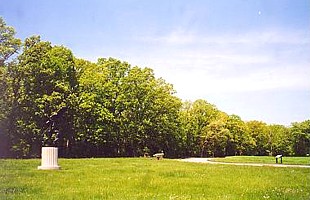
|
| Gettysburg NMP |
History
On the second day of the Battle of Gettysburg, Union forces defended a fishhook-shaped range
of hills and ridges south of Gettysburg with some 90,000 soldiers. Confederate lines essentially wrapped around the Union
position with 70,000 soldiers. On the afternoon of July 2, 1863, Gen. Robert E. Lee launched a heavy assault on the Union
left flank, and fierce fighting raged at Devil's Den, Little Round Top, the Wheatfield, the Peach Orchard and Cemetery Ridge.
On the Union right, demonstrations escalated into full-scale assaults on Culp's Hill and East Cemetery Hill. Although the
Confederates gained ground, the Union defenders still held strong positions by the end of the day.
Warfield Ridge, which would host two Confederate divisions on the second day of battle, is actually
the southern extension of Seminary Ridge south of Pitzer Woods and the Millerstown Road. The gentle ridge veers in a southeasterly direction where it is intersected by the
Emmitsburg Road. This ridge was heavily wooded at the time of the battle and provided excellent concealment for Longstreet's
Confederate troops who sheltered here prior to the attack on the afternoon of July 2. The trees screened the Southern line
of march from any Union vantage point, including that of the signalmen on Little Round Top. The last troops into line were also the first to step off toward the Union left flank from this point. Brig.
Gen. Evander Law's Alabama brigade of Maj. Gen. John Bell Hood's Division marched over 18 miles to get to this point and then
began the attack at 4 o'clock without the benefit of water. Thirsty soldiers handed over their empty canteens to several men
who were detailed to find a well and fill them, but they had not returned before the attack began. (The canteen detail never
did return; all were captured with the filled canteens while attempting to locate their comrades.) The lack of water would
play a major role in fatigue and exhaustion during the ensuing fight.
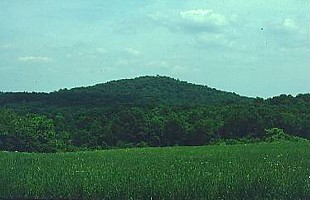
(Right) Big Round Top from Warfield Ridge. Hood believed that the
heavily wooded hill could conceal his march around and into the Union rear. Photo Gettysburg NMP.
Maj. Gen. John Bell Hood was the division commander for the Rebel soldiers here. Brave and audacious,
Hood was uneasy with the assignment given him especially after he surveyed the ground east of Warfield Ridge. Union signalmen
on top of Little Round Top could easily see his troops and Yankee batteries at Devil's Den and the Peach Orchard had a clear field of fire on his formations. Supporting Confederate batteries
on Warfield Ridge were not enough to suppress the Union artillery and his soldiers had no chance to defend themselves until
they closed on the enemy positions. Hood encountered Lt. Gen. Longstreet and proposed a change of plans- he would move his division further south around
Big Round Top and attack behind the Union line to throw the Union guns off Devil's Den from the rear. Hot and frustrated by
a day full of delays, a stubborn Longstreet replied that Gen. Lee's orders to attack up the Emmitsburg Road had to be carried
out as ordered. Hood protested. Again Longstreet stated, "We must obey the orders of Gen. Lee." Hood turned to rejoin his
troops as Longstreet rode to meet with his other division commander, Maj. Gen. McLaws. Moments after this encounter, Hood
was seriously wounded near this location and carried from the field. Brig. Gen. Evander Law stepped into his place and directed
the division for the remainder of the battle.
| Warfield Ridge and Battle of Gettysburg |
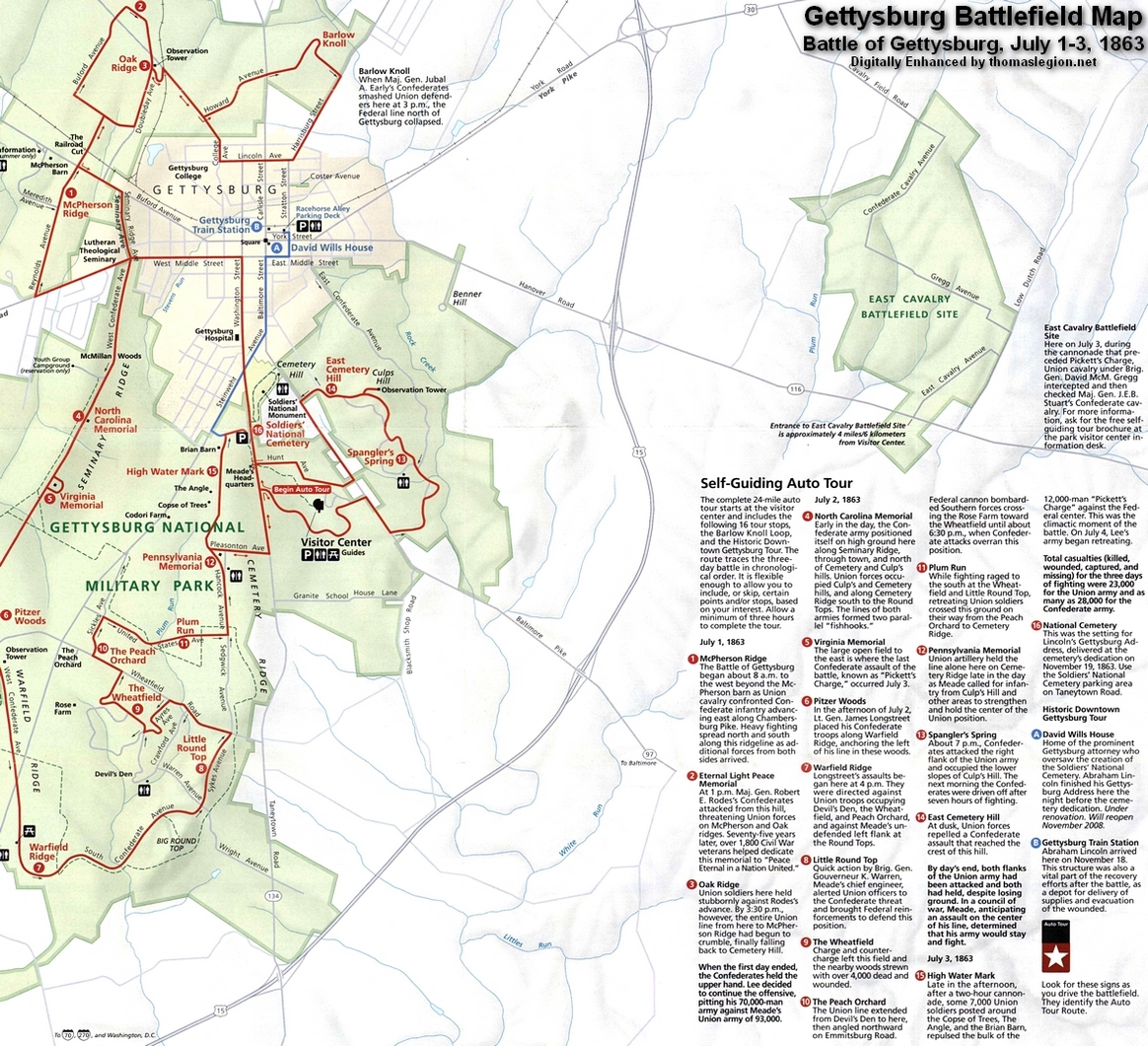
|
| Official Gettysburg Battlefield Map |
| General Hood |

|
| Generals in Gray |
The loss of Hood was keenly felt; Law had no idea of the route of attack Gen.
Lee had ordered. "We advanced to the attack," wrote Brig. Gen. Evander Law, "The artillery on both sides had been warmly engaged
for about fifteen minutes and continued to fire heavily until we became engaged with the Federal infantry..." Overlooking
the assault were Union signal men stationed on Little Round Top. Law knew the importance of the hill and of the adjacent Big
Round Top, which "rose like a huge sentinel guarding the Federal left flank."
The opening charge was directed against Union troops occupying Devil's Den. But Law's brigade, now commanded
by Colonel William C. Oates of the 15th Alabama Infantry, was forced to move further to the right toward Big Round Top to escape
the concentrated fire coming from Union artillery at Devil's Den, the Wheatfield and the Peach Orchard.
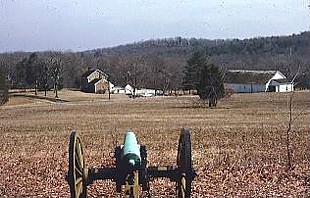
(Right) Photo of Little Round Top from Warfield Ridge. Hood's men
had to march across the Bushman Farm (foreground) under fire from Union artillery to reach Devil's Den. Gettysburg NMP.
The Southerners rushed over farm fields scattered with large boulders and
dense thickets, divided by stout rail and stone fences. US Sharpshooters peppered the Southern ranks with a deadly fusillade
but the Confederates kept moving. Law's brigade split in half, one portion headed to flank the Union guns at Devil's Den and
the other to strike Little Round Top. Instead of flanking Devil's Den, Law's left half was met by Union troops rushed
into the small valley to stem the attack. Adjacent to Law's brigade, Robertson's Texas Brigade also moved swiftly down the
slope of Warfield Ridge through the Bushman Farm and charged the Union battery posted on top of Devil's Den, applying deadly
pressure to the New York artillerymen from front and flank. Law's right wing continued northward. His right regiment, the
15th Alabama, marched over the summit of Big Round Top before running straight into a Union
brigade posted on the southern slope of Little Round Top.
The Bushman and Slyder Farms that lie between Warfield Ridge and Big Round
Top are more heavily wooded today than in 1863. Both farms were small family operations and the farmers had cleared trees
from most of the area up to the slopes of Big Round Top for pasture and crops. Every inch of land here was precious as the
soil was not of the same good quality as those farms north of Devil's Den. Since that time, the land has been constantly farmed
and used for purposes other than remaining as open fields as in 1863. Gettysburg National Military Park's approved 1999 General
Management Plan included a proposal to rehabilitate and restore this farmland to its pre-1920s appearance. Tree removal and
land reclamation began in the winter of 2002-2003 and has been very successful, returning the area to its historic appearance
and field patterns. Visitors can now appreciate the open terrain and distance Southern troops had to cross to get into the
fighting.
"They held the right wing of Lee's valiant host..."
| 2nd Day Battle of Gettysburg, July 2, 1863 |
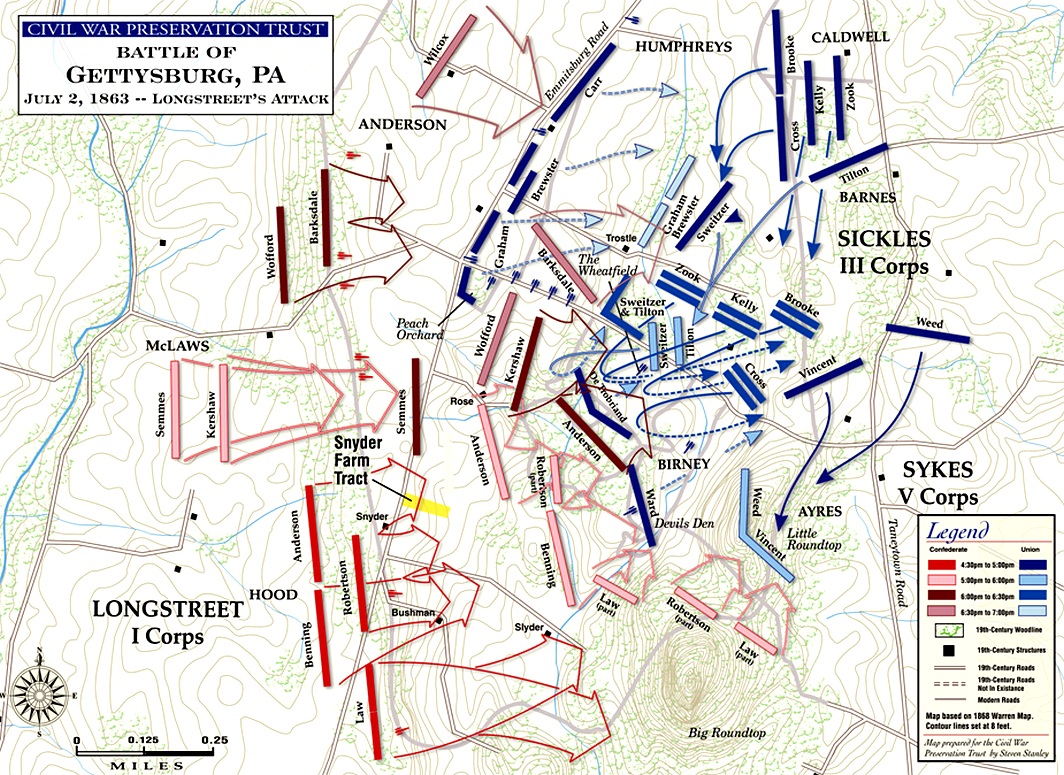
|
| Longstreet's Attack, Gettysburg, July 2, 1863 |
| The Alabama Monument |
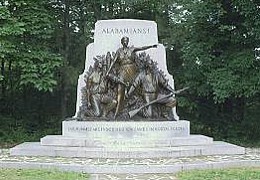
|
| Gettysburg NMP |
On the southern tip of Warfield Ridge stands the Alabama Monument, that state's tribute to the Alabamians
who served at Gettysburg. It was from this location that Law's brigade of Alabama regiments initiated Longstreet's attack
against Devil's Den and Little Round Top on the second day of the battle. A central female figure represents the state of
Alabama and signifies pride in her native sons kneeling beside her, as she points in the direction they must go. A wounded
soldier passes his cartridge box to the figure of "Determination" who will continue into battle despite the odds. Set on a
base of Vermont Granite and surrounded by a flagstone terrace and walk, this handsome monument cost the state of Alabama $12,000
to erect. The design and sculpture is the work of artist Joseph W. Urner of Frederick, Maryland. It was dedicated by the Alabama
Division of the United Daughters of the Confederacy on November 12, 1933.
Analysis
Gen. Robert E. Lee had planned an assault against Union positions on
the afternoon of July 2, but was delayed, however, because Lt. Gen. James Longstreet had to wait for his final brigade
(Evander M. Law's, Hood's division) to arrive, and then he was forced to march on a long, circuitous route that could not
be seen by Union Army Signal Corps observers on Little Round Top. It was 4 p.m. by the time his two divisions reached their
jumping off points, and then he and his generals were astonished to find the III Corps planted directly in front of them on
the Emmitsburg Road. Hood, arguing with Longstreet, insisted that the development demanded a change in tactics. He wanted
to swing around, below and behind, Round Top and hit the Union Army in the rear, but Longstreet refused to consider such a
modification to Lee's order. Nevertheless, and partly because of Sickles'
unexpected location, Longstreet's assault would not proceed according to Lee's plan. Instead of wheeling left to join a simultaneous
two-division push on either side of the Emmitsburg Road, Hood's division attacked in a more easterly direction than intended,
and McLaws' and Anderson's divisions deployed brigade by brigade, in an en echelon style of attack, also heading more to the
east than the intended northeast.
Lee's inability to coordinate his units would result
in a series of disjointed attacks on the 2nd day of fighting. Underestimating Meade's strength, poor logistics,
including the lack of sufficient drinking water, and inadequate reserves would contribute to the high casualties
in the Southern ranks on this day. Lee's refusal and failure
to avoid Union strongpoints would continue through the 3rd and final day at Gettysburg. According to Sun Tzu, when the enemy is strong avoid him, and where he is weak, attack
him. While Lee committed many blunders by pushing his grand army into Pennsylvania, he could ill-afford the tremendous, irreplaceable
casualties that occurred here. His battered and demoralized army would now crawl back to Virginia, only to never
invade Northern soil again. Meanwhile, fresh troops continued to fill and replenish the ranks of the Army of the Potomac.
Casualty figures for the second day of Gettysburg are difficult to ascertain
because both armies reported by unit after the full battle, not by day. One estimate is that the Confederates lost approximately
6,000 killed, missing, or wounded from Hood's, McLaws', and Anderson's divisions, amounting to 30–40% casualties. Union
losses in these actions probably exceeded 9,000. One estimate for the day's total (including the Culp's and Cemetery Hill
actions) show 10,000 Union and 6,800 Confederate casualties. This is in comparison to approximately 9,000 Union and 6,000
Confederate casualties on the first day, although there were much larger percentages of both armies engaged on the second
day. Some estimates of total casualties for the day run as high as 20,000 and declare it the bloodiest day of the Battle
of Gettysburg. It is, notwithstanding, a testament to the ferocity of the day's battle that such high casualties figures
resulted even with much of the fighting not occurring until late in the afternoon and thereafter lasting about six hours.
By comparison, the Battle of Antietam—known famously as the bloodiest single day in American military history with nearly
23,000 casualties—was an engagement that lasted twelve hours, or about twice as long.
Sources: National Park Service; Gettysburg National Military Park; Official
Records of the Union and Confederate Armies; Civil War Trust.
Recommended Reading: Gettysburg--The Second Day, by Harry W. Pfanz (624 pages). Description: The second day's fighting at Gettysburg—the
assault of the Army of Northern Virginia against the Army of the Potomac on 2 July 1863—was
probably the critical engagement of that decisive battle and, therefore, among the most significant actions of the Civil War.
Harry Pfanz, a former historian at Gettysburg National Military Park,
has written a definitive account of the second day's brutal combat. He begins by introducing the men and units that were to
do battle, analyzing the strategic intentions of Lee and Meade as commanders of the opposing armies, and describing the concentration
of forces in the area around Gettysburg. He then examines
the development of tactical plans and the deployment of troops for the approaching battle. But the emphasis is on the fighting
itself. Pfanz provides a thorough account of the Confederates' smashing assaults—at Devil's Den and Little Round Top,
through the Wheatfield and the Peach Orchard, and against the Union center at Cemetery Ridge. Continued below...
He also details
the Union defense that eventually succeeded in beating back these assaults, depriving Lee's gallant army of victory. Pfanz
analyzes decisions and events that have sparked debate for more than a century. In particular he discusses factors underlying
the Meade-Sickles controversy and the questions about Longstreet's delay in attacking the Union left. The narrative is also enhanced
by thirteen superb maps, more than eighty illustrations, brief portraits of the leading commanders, and observations on artillery,
weapons, and tactics that will be of help even to knowledgeable readers. Gettysburg—The
Second Day is certain to become a Civil War classic. What makes the work so authoritative is Pfanz's mastery of the Gettysburg literature and his unparalleled knowledge of the ground on
which the fighting occurred. His sources include the Official Records, regimental histories and personal reminiscences from
soldiers North and South, personal papers and diaries, newspaper files, and last—but assuredly not least—the Gettysburg
battlefield. Pfanz's career in the National Park Service included a ten-year assignment as a park historian at Gettysburg. Without doubt, he knows the terrain of the battle as well
as he knows the battle itself.
Recommended
Reading:
The Artillery of Gettysburg (Hardcover). Description:
The battle of Gettysburg in July 1863, the apex of the Confederacy's
final major invasion of the North, was a devastating defeat that also marked the end of the South's offensive strategy against
the North. From this battle until the end of the war, the Confederate armies largely remained defensive. The Artillery of
Gettysburg is a thought-provoking look at the role of the artillery during the July 1-3, 1863 conflict. Continued below...
During the
Gettysburg
campaign, artillery had already gained the respect in both armies. Used defensively, it could break up attacking formations
and change the outcomes of battle. On the offense, it could soften up enemy positions prior to attack. And even if the results
were not immediately obvious, the psychological effects to strong artillery support could bolster the infantry and discourage
the enemy. Ultimately, infantry and artillery branches became codependent, for the artillery needed infantry support lest
it be decimated by enemy infantry or captured. The Confederate Army of Northern Virginia had modified its codependent command
system in February 1863. Prior to that, batteries were allocated to brigades, but now they were assigned to each infantry
division, thus decentralizing its command structure and making it more difficult for Gen. Robert E. Lee and his artillery
chief, Brig. Gen. William Pendleton, to control their deployment on the battlefield. The Union Army of the Potomac
had superior artillery capabilities in numerous ways. At Gettysburg,
the Federal artillery had 372 cannons and the Confederates 283. To make matters worse, the Confederate artillery frequently
was hindered by the quality of the fuses, which caused the shells to explode too early, too late, or not at all. When combined
with a command structure that gave Union Brig. Gen. Henry Hunt more direct control--than his Southern counterpart had over
his forces--the Federal army enjoyed a decided advantage in the countryside around Gettysburg. Bradley
M. Gottfried provides insight into how the two armies employed their artillery, how the different kinds of weapons functioned
in battle, and the strategies for using each of them. He shows how artillery affected the “ebb and flow” of battle
for both armies and thus provides a unique way of understanding the strategies of the Federal and Union
commanders.
Recommended Reading: Gettysburg,
by Stephen W. Sears (640 pages) (November 3, 2004). Description: Sears delivers another masterpiece with this comprehensive study of America’s most studied Civil War battle. Beginning with Lee's meeting with
Davis in May 1863, where he argued in favor of marching north, to take pressure off both Vicksburg and Confederate logistics. It ends with the battered Army
of Northern Virginia re-crossing the Potomac just two months later and with Meade unwilling to drive his equally battered
Army of the Potomac into a desperate pursuit. In between is the balanced, clear and detailed
story of how tens-of-thousands of men became casualties, and how Confederate independence on that battlefield was put forever
out of reach. The author is fair and balanced. Continued below...
He discusses the shortcomings of Dan Sickles, who
advanced against orders on the second day; Oliver Howard, whose Corps broke and was routed on the first day; and Richard Ewell,
who decided not to take Culp's Hill on the first night, when that might have been decisive. Sears also makes a strong argument
that Lee was not fully in control of his army on the march or in the battle, a view conceived in his gripping narrative of
Pickett's Charge, which makes many aspects of that nightmare much clearer than previous studies. A must have for the Civil
War buff and anyone remotely interested in American history.
Recommended Reading: Hallowed Ground: A Walk at Gettysburg, by James M. Mcpherson (Crown Journeys) (Hardcover). Review From
Publishers Weekly: The country's most distinguished
Civil War historian, a Pulitzer Prize winner (for Battle Cry of Freedom) and professor at Princeton,
offers this compact and incisive study of the Battle of Gettysburg. In narrating "the largest battle ever fought in the Western Hemisphere," McPherson walks readers over its presently hallowed ground, with monuments numbering
into the hundreds, many of which work to structure the narrative. They range from the equestrian monument to Union general
John Reynolds to Amos Humiston, a New Yorker identified several months after the battle when family daguerreotypes found on
his body were recognized by his widow. Indeed, while McPherson does the expected fine job of narrating the battle, in a manner
suitable for the almost complete tyro in military history, he also skillfully hands out kudos and criticism each time he comes
to a memorial. Continued below...
He praises
Joshua Chamberlain and the 20th Maine, but also the 140th New York
and its colonel, who died leading his regiment on the other Union flank in an equally desperate action. The cover is effective
and moving: the quiet clean battlefield park above, the strewn bodies below. The author's knack for knocking myths on the
head without jargon or insult is on display throughout: he gently points out that North Carolinians think that their General
Pettigrew ought to share credit for Pickett's charge; that General Lee's possible illness is no excuse for the butchery that
charge led to; that African-Americans were left out of the veterans' reunions; and that the kidnapping of African-Americans
by the Confederates has been excised from most history books.
Recommended Reading: Gettysburg: A Testing of Courage. Description:
America's Civil War raged for more than four years, but it is the three
days of fighting in the Pennsylvania
countryside in July 1863 that continues to fascinate, appall, and inspire new generations with its unparalleled saga of sacrifice
and courage. From Chancellorsville, where General Robert E. Lee launched his high-risk campaign into the North, to the Confederates'
last daring and ultimately-doomed act, forever known as Pickett's Charge, the battle of Gettysburg gave the Union army a victory
that turned back the boldest and perhaps greatest chance for a Southern nation. Continued below...
Now, acclaimed
historian Noah Andre Trudeau brings the most up-to-date research available to a brilliant, sweeping, and comprehensive history
of the battle of Gettysburg that sheds fresh light on virtually every aspect of it. Deftly balancing his own
narrative style with revealing firsthand accounts, Trudeau brings this engrossing human tale to life as never before.
Recommended
Reading: The Maps of Gettysburg:
The Gettysburg Campaign, June 3 - July 13, 1863
(Hardcover). Description: More academic and photographic
accounts on the battle of Gettysburg exist than for all other
battles of the Civil War combined-and for good reason. The three-days of maneuver, attack, and
counterattack consisted of literally scores of encounters, from corps-size actions to small unit engagements. Despite all
its coverage, Gettysburg remains one of the most complex and
difficult to understand battles of the war. Author Bradley Gottfried offers a unique approach to the study of this multifaceted
engagement. The Maps of Gettysburg plows new ground in the study of the campaign by breaking down the entire campaign in 140
detailed original maps. These cartographic originals bore down to the regimental level, and offer Civil Warriors a unique
and fascinating approach to studying the always climactic battle of the war. Continued below...
The Maps of
Gettysburg offers thirty "action-sections" comprising the entire campaign. These include the march to and from the battlefield,
and virtually every significant event in between. Gottfried's original maps further enrich each "action-section." Keyed to
each piece of cartography is detailed text that includes hundreds of soldiers' quotes that make the Gettysburg
story come alive. This presentation allows readers to easily and quickly find a map and text on virtually any portion of the
campaign, from the great cavalry clash at Brandy Station on June 9, to the last Confederate withdrawal of troops across the
Potomac River on July 15, 1863. Serious students of the battle will appreciate the extensive
and authoritative endnotes. They will also want to bring the book along on their trips to the battlefield… Perfect for
the easy chair or for stomping the hallowed ground of Gettysburg,
The Maps of Gettysburg promises to be a seminal work that belongs on the bookshelf of every serious and casual student of
the battle.
|

